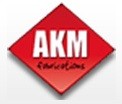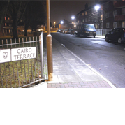Barriers
In construction, barriers are erected to protect pedestrians, cars and the construction crew from the potential dangers of the construction site, whether this is heavy plant machinery, dust or falling debris. Barriers play another role in that they safeguard the site from unauthorised personnel who might want to gain access to steal or vandalise machinery and/or materials. Barriers can be temporary or (semi)permanent structures. Precast concrete barriers are often set up especially on road construction as it protects the workers from cars. Pedestrian barriers, which are metal stands on 'feet', can be used to create a temporary walkway for workers. Other kinds of barriers can be made of plastic or chain-link fencing. Some barriers can have barbed wire placed on top as an added deterrent or have reflective materials so they are visible at night especially at roadworks. Some barriers are not removed after the construction work is finished but are kept as a divider or for reasons of privacy or as a sound barrier. Barriers can be seen on all building sites or at roadworks and are an important measure to ensure the prevention of accidents. After the construction work has been completed, barriers are retained around many properties to delineate the perimeter fence against possible intruders.
-
Heald Ltd
View company profileInnovation is at the core of what Heald does. We have a range of unique, patent protected products, meaning you will find nothing else like our bollards and roadblockers on the market. We have been listed in the IP100 League Table for three consecutive years, always ranking in the top ten companies and have been recognised for our innovation with numerous awards.
-
Greenbarnes Ltd
View company profileAt Greenbarnes Ltd, we specialise in supplying high quality notice boards, street and church furniture, honours boards and cabinet making to a broad spectrum of sectors.
Our hardwood notice boards are perfect for rural villages for example where a traditional appearance is of aesthetic importance.
-
Perancea Ltd
View company profileWith a wealth of experience, Perancea is able to provide custom and standard enclosures to meet the exacting needs of a broad range of application requirements from mechanical to electrical and electronics engineering solutions. The company is also a highly experienced mechanical engineering organisation, specialising in the production of all types of enclosures including RFI/EMI shielding solutions and plastic and metal fabrication for the electrical, electronics and associated industries.
Perancea: A myriad of electronic packaging solutions
-
Compass Protection Manufacturing Ltd
View company profileAt Compass Protection Manufacturing Ltd, we specialise in providing protective crash barriers and offer a full installation service. We supply Armco-type crash barriers, the most widely used crash barriers. They are frequently seen on motorways, around private building and carparks, and alongside private roads.
-
AKM Fabrications Ltd
View company profileAKM FABRICATIONS LTD are based in Chorley, and supply products Nationwide. We supply Rubbish Chutes – Guard Rail Systems – Temp Guardrail System - Walkways & Rooflight Covers - Demarcation Systems - Ladders & Platforms in galvanised and aluminium - Mobile Man Achors – Air Conditioning Stands – Cable Tray Stands and also produce bespoke steel work. We specialise in sheet metal work, we produce many of our in-house designed products.
We are committed to the constant improvement of our exisiting products and in the develpment of new ones, and are fully focused on providing our customers with the best possible service. AKM Fabrications has achieved CE Marking BS/EN 1090-1. This standard regulates the fabrication and assembly of load bearing structual steel components up to EXC 2 in accordance to BS EN 1090-2:2008 + A1:2011 as of the 1st July 2014 CE Marking became mandatory.
-
Plastor Ltd
View company profileAt Plastor we specialise in supplying a comprehensive range of plastic boxes / containers, storage equipment and materials handling products to companies big and small, across all industries.
Our large range of plastic boxes are available in all sizes and are suitable for all types of applications. Our huge range of plastic boxes consists of food grade containers, stacking and nesting containers (saving valuable storage space), containers with wheels, extra large distribution boxes, storage boxes with and without lids, boxes with hand holes for easy transporting, clear / transparent containers, ventilated containers, anti-static containers (ideal for electrical parts and engineering components) and much more.
-
Gemma Lighting Ltd
View company profileGemma Lighting Ltd are an innovative, energy conscious and environmentally friendly LED Street Light Manufacturer.
From their UK manufacturing facility in Portsmouth, Gemma Lighting draw on their vast LED Lighting experience which dates back to 2003. Their products are equipped with the latest technology in high brightness LED's and they can provide energy efficient lighting solutions for all of your requirements which also includes Cold Store Lighting.
As an LED Street Light Manufacturer, Gemma Lighting have designed a series of LED Street Lights which offer significant carbon and energy reduction.
-
MK Profile Systems Ltd
View company profilemk Profile Systems offer a comprehensive modular system for machine construction and factory automation based on our aluminium profile systems.
Our products include a range of over 250 aluminium profiles and accessories which can be used for machine frames, bespoke guarding, perimeter fencing, workstations, stairs and platforms.
mk conveyor technology modules can meet virtually any requirement for the transport and handling of piece goods in three dimensional factory automation applications.
We also offer a range of system solutions, both transfer and handling systems, which are all modular and fully compatible with our profile system.
-
Brooks Forgings Ltd
View company profileBrooks Forgings Ltd, established in 1960, is a leading UK manufacturer of Forged, Fabricated and Machined components.
We have a comprehensive range of manufacturing processes at our UK based facility and this aids buyers source their full requirements from one supplier.
These processes include:- Robot Forging
- Upset Forging (16 cells)
- Drop Forging (10 cells)
- Horizontal Counterblow Forging
- Hand Forging
- Machining (14 cells)
- Fabrication & Assembly
- Robot Welding (5 cells)
- Flash Butt Welding
- Hot & Cold Bending
- Hot & Cold Pressing
- Thread Rolling
- Ring Rolling
- Swaging & Pointing
- Die Sinking
- Marking & Traceability
- Forging Simulation
- 3D Printing
- Reshoring
- 250 Tonnes of Raw Material
- 2500 Pallets of Customer Stock
-
Omos Ltd
View company profileLeading the way in street furniture design and innovation, Omos manufactures a comprehensive range of contemporary products including litter bins, recycling bins, benches, seats, tree planters and grilles, bollards, ashtrays, picnic sets, cycle stands and shelters.
Omos has been designing and manufacturing street furniture since 1996. Our products have received numerous awards including The Glen Dimplex Grand Prix, The ICAD Silver Bell, The Louth County Council and Carlow County Council Street Furniture Awards and most recently the 2014 IPA Designer of the Year Award.
-
GPS Perimeter Systems Ltd
View company profileHere at GPS Perimeter Systems, we are experts in the supply of affordable external perimeter security systems. Our perimeter security systems detect intruders outside before they can do any damage. We have over 25 years of experience in fence security, perimeter security and infrared systems to meet individual requirements.
-
FFD Catering Equipment
View company profileOffering a comprehensive range of commercial catering equipment and supplies from market leading brands, we guarantee high quality at great prices. Whatever you're searching for, from commercial ovens, fryers or microwaves to warewashers, clothing or kitchen utensils, we have the perfect product to suit all demands.
FFD Catering Equipment is a subsidiary company of Fridge Freezer Direct Ltd. a business specialising in the supply of commercial refrigeration to the catering and hospitality sector. Now branching out into catering equipment, our knowledgeable sales team and dedicated customer service bring over 10 years of experience, guaranteeing you are in safe hands every time you shop.
Our aim is to deliver the widest range of products at the best possible prices ensuring that every business can benefit from superior quality and professional performance, whatever the budget. FFD Catering Equipment is fully ISO compliant, meaning that our customers are guaranteed safety and security during every stage of the shopping process.
-
Dexion Anglia Ltd
View company profileEstablished over 25 years ago we are still supplying & Installing Genuine Dexion products all over East Anglia including; Suffolk, Norfolk, Cambridgeshire & Lincolnshire .
At our warehouse based in the heart of Kings Lynn, Norfolk we hold a vast amount of Dexion Products which is growing on a weekly basic. This is set up to showcase the various Dexion Products in a storage environment. Dexion P90 Adjustable Pallet Racking is one of the UK and Europe's leading pallet racking system, with the ability of storing heavy loads and on a fast turn-around.
Over the years we have worked tirelessly to ensure we provide a professional & safe service to thousands of customers including: NHS, Police Authorities, Ministry of Defence and large food processing companies.
Our experienced sales staff are on the road covering East Anglia and through the UK looking at projects of all sizes, as well as our trained office based staff answering all enquiries and handling orders.













